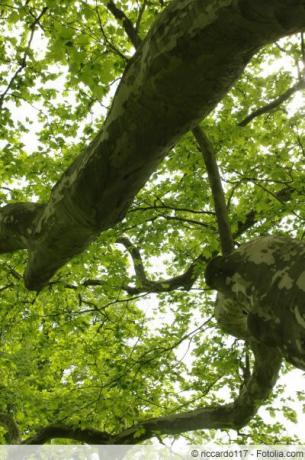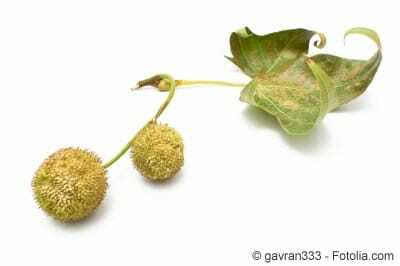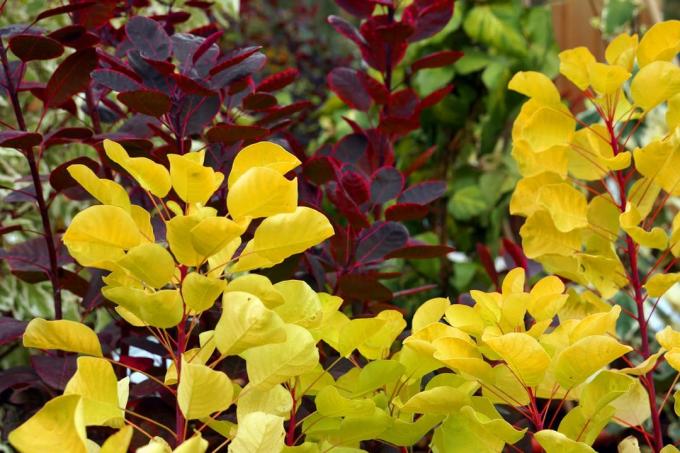

Table of contents
- Short profile
- Care of the London Plane Tree
- site conditions
- Plant
- watering and fertilizing
- Pruning of London plane tree
- Cutting the roof plane
- Topiary in winter
- diseases and pests
- Cancer (Nectria galligena)
- Massaria (Splanchnonema platani)
- Plane leaf tan
- Conclusion
Uncut, the trees grow 30 m high and more and also up to 20 m wide. The growth in length in one year can be up to 50 cm. A lot of space is required for this. This is usually rather tight in home gardens today. That is why the plane tree grown as a roof or umbrella is usually planted there, with the main shoot being cut off. The branches are then guided horizontally. Over the years, they form a dense and natural roof. Before planting, you should consider that the roots of the plane tree are also large, always adapting to the crown. They are also very strong. All in all, this wood is very beautiful. The trunk is particularly striking. The maintenance effort is low, only the shape of the roof has to be cut regularly. In the following text you can read what to consider when handling the maple-leaved plane tree.
Short profile
- Platanus x hispanica, syn. Platanus x acerifolia, Platanus x hybrida)
- Plane family
- Hybrid breeding from different plane trees
- Deciduous tree, 30 to 40 m tall
- Crown up to 20 m wide
- The peeling bark is typical
- High and wide treetop
- Leaves very maple-like, shiny dark green
- Monoecious of separate sexes
- Flowers in May, along with foliage
- Rather inconspicuous and small
- Globular seed fruit
- Stay on the tree through the winter
- heart root
- Rare and beautiful cultivated form - Suttneri - white variegated leaves, only 22 m high
- Interesting shape - roof plane tree - horizontal growth through training pruning and directing the shoots
Care of the London Plane Tree
The care of the maple-leaved plane tree is uncomplicated. With a favorable location and good plant substrate, it requires little care. Watering after planting is important, but once established, the shrubs can cope with drought, even if they actually prefer slightly moist soil.
site conditions

Plane trees like the sun and can also cope with a full sun location. Much more important than the sun's rays, however, is that there is enough space for the tree and, above all, for its roots. Root growth is strong and scales with the size of the crown. The roots of roof planes remain smaller, but still grow 6 to 8 m in width. Plane trees have strong roots that can easily lift paving or flagstones. Pipelines are also at risk.
- Sunny, also full sun
- Maximum semi-shade
- Plan plenty of space all around
- Strong root growth
The shrubs do not make any great demands on the plant substrate. From sandy to loamy, they get along with almost any soil. But they prefer slightly moist soil, even if they can cope with drought. It is favorable if the substrate is somewhat nutritious.
- Little demanding
- Sandy to loamy
- Moderately sour
- Also tolerates calcareous and neutral soils
- Mulch the soil to retain moisture.
Plant
When planting, it is important to consider how high and strong such a plane tree can become. The roots are spreading and have a lot of power. Such a tree is best placed in the open, meters away from a building, neighbors, pipes and the like. Plane trees are often sold in bales. The season for sale starts around mid-November and ends in April. The trees can be planted at any time, except when there is frost. Container goods are usually available all year round and can also be planted immediately after purchase, with the exception of frost periods, of course.
- Plant balled crops from mid-November
- Container goods all year round
The planting hole should be twice the size of the root ball. It is important to dig a hole with straight walls so that the root ball can rest completely on the bottom. Cavities should be avoided. The plane tree should not be planted too deep. It must be at the same height as in the nursery. If necessary, the soil from the excavation can be improved accordingly.
- Twice the size of the planting hole
- The bale must lie completely on the bottom
- Plant at the same height as in the nursery
It is advisable to bury a tree stake so that the trunk of the tree can grow straight. The stake is embedded in the ground before planting, approx. 1/3 deep. It should be 2.5 m long. The pole is ideally placed on the south-west side, because then it will be blown away from the tree by the wind. This prevents damage to the tree trunk. It is best to use a rubber band to tie it up, also to avoid damaging the bark. Leave the post for at least 2 years, then the tree will be well anchored.
- Tree stake is recommended
- 2.5m long
- Placed on the south-west side
watering and fertilizing

Watering is very important for newly planted and young trees. It must be watered regularly until it grows, especially deeply, not just superficially. Older trees and shrubs can also cope with drought, as long as it is not a permanent condition. Slightly moist soil is better than too dry.
- Water regularly, especially young and freshly planted specimens
- Older ones tolerate occasional drought
- No permanent wetness
Organic fertilizer is recommended for fertilization. This improves the soil and only gradually releases the nutrients. This avoids over-fertilization. Cow manure and compost are good fertilizers. Too much fertilizer is significantly more harmful than too little.
Pruning of London plane tree
Plane trees are generally easy to cut. It always depends on what you want to achieve with a cut. So-called roof sycamores have to be cut the hardest and most frequently. On the other hand, trees that can grow according to their natural shape and size require almost no pruning. Something can be thinned out here in the first few years. Later you can no longer get to the branches.
Cutting the roof plane
Plane trees are cut very young, already in the tree nursery, so that the crown can develop as desired. It is crucial that the main branch is in relation to the other branches. So there must be an equal number of side shoots on the sides of the main shoot. Crossing shoots are removed. The tree is sold with a well-developed crown. If a tall trunk is desired, the long side branches of the London Plane should be removed in June. It is cut in stages. First a saw cut is made on the underside of the branch, then sawed from above. It is important to keep some distance from the trunk. That way the branches don't tear off the tree. Saw thick branches at least 10 cm away from the trunk. If it breaks off and the bark tears, then not up to the trunk. The damage can be repaired. The remaining "stump" is then sawed off in such a way that no coat hook remains. It is important not to injure the branch collar. For large wounds, a wound remedy is recommended. This prevents infection and bleeding of the tree.
- Remove side branches in June.
- Cut except for an outward-facing eye.
In winter, pruning is performed only correction of the crown. Pruning takes place between October and February, when there are no leaves. The young shoots of last summer are cut back to 5 cm. It is important not to cut in frost and not in the sun.
Topiary in winter
The leaves of the plane trees are slightly hairy and dusty when cut. People with allergies often have problems with it. The presence of a tree is often enough.
diseases and pests

Although plane trees are very robust, they can still be affected by some diseases. There are even diseases specific to plane trees. Mushrooms in particular trigger this.
Cancer (Nectria galligena)
- Fungal attack that cracks the bark, sometimes very severe. Remove and burn affected twigs and branches as soon as possible. The worst case is when the trunk is affected. Here it is advisable to consult a specialist who is familiar with the disease and cutting.
- Cut out affected areas
- Consult a specialist at Stamm
Massaria (Splanchnonema platani)
- also fungal attack, which only occurs on plane trees. The fungus clogs the pathways. The result is that branches die off, whether smaller or larger and how many depends on the circumstances. An indication of the infestation can be dry leaves in the crown. The disease can be recognized at the cutting points of the removed branches. Black discolouration can be seen. There's nothing you can do except cut it out.
- Dying branches and twigs
- cut out
Tip:
Do not prune when wet if prune is required for disease. The fungal spores can then penetrate the wood better.
Plane leaf tan
- Brown spots spread from the leaf veins, which become larger and larger and can affect the entire leaf. The causative agent, in turn, is a fungus. The disease often occurs in cool, rainy springs. The leaves fall off, premature defoliation occurs. Usually affected only in the first generation of leaves. As a rule, the trees regenerate quickly. No pesticides are permitted for the home garden area. It is therefore important to completely remove infested fallen leaves. Affected branches and twigs should be removed, but only in the winter months.
- Brown spots starting from the leaf veins
- No pesticides
- Collect fall foliage
- Cut (open) affected branches in winter
Conclusion
A maple-leaved plane tree is a good house tree for those who have space in height and width. However, it can grow very tall and wide, and the tree also needs a lot of space underground for its strong roots. Therefore, the plane tree cannot be planted in every place. Specimens that are raised early as umbrellas or roofs are cheaper. These trees remain manageable, but also get a strong root. These topiaries need a little more attention, they need regular pruning. Otherwise you don't have much work with the plane tree and you have a decorative tree.
 garden editorial
garden editorial I write about everything that interests me in my garden.
Learn more about P like Primrose

Smoke bush, Cotinus coggygria: Care from A - Z
Popular because of its filigree growth and its special foliage color in autumn, this ornamental bush acts as a real eye-catcher in your own garden. We are talking about the willow tree (Cotinus coggygria), which is particularly popular as a solitary tree.
Purple bells - profile, care tips and propagation
The Heuchera, the purple bell, originally comes from America, from Canada to Mexico. Today there are numerous, beautiful hybrids with a wide variety of leaf shapes, colors and flowers for home gardens to buy. The Heuchera species are evergreen, clump-forming perennials from the Sacifragaceae family.
pushkinia; Puschkinia libanotica – care for early bloomers
Blooms early, blooms enchantingly. Is hardy, durable and easy to care for. But despite all these advantages, the Puschkinia is still almost an insider tip. The delicate white flowers of this bulbous plant sway out of their long, light green leaves. The Puschkinia libanotica belongs to the plant family of the asparagus family (Asparagaceae).

Petunias, Petunia – common diseases and pests
Petunias are among the most popular balcony and tub plants. Their abundance of flowers and the numerous varieties in different colors and with different patterns make these plants so popular. However, petunias are also a bit sensitive and sometimes downright bitchy if they don't find all the conditions they would like.
Plant pampas grass - location, distance, fertilizing & Co
Pampas grass is garden usually stands out from the rest of the planting. This tall grass with its impressive bud sites is hard to miss. It works best as a solitaire. After a few years, a really large eyrie has developed. In a solitary position, perhaps in the middle of the lawn, the pampas grass looks more than good. In addition, it is also extremely easy to care for.

Instructions: Cut the chanterelle tree - this is how it's done!
The pipe bush is usually referred to as false jasmine, sometimes also as farmer's or summer jasmine. This flowering shrub has many names. Typical of the chanterelle tree are the numerous white flowers, simple, semi-double or double and an intense fragrance. Not all varieties smell, but most do, sometimes more, sometimes less.


